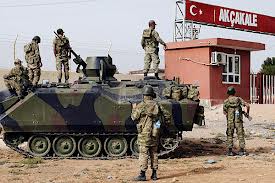On October 10, 2012, Turkey forced the landing of a civilian jetliner on route from Moscow to Damascus, on suspicion of it carrying a weapons shipment bound for the Syrian government. This is the latest escalation of an ensuing confrontation between the two states that began after a Syrian shell killed five Turkish civilians on October 3, in the border town of Akcakale. As a longstanding NATO member, Turkey has expressed strong outrage over the spillover of conflict onto its territory. Furthermore, since article five considers “an attack on one as an attack on all,” many are beginning to ask the question, is intervention on the part of the Alliance in the cards?
The recent action taken by the Turkish government is another signal of how tense the situation has become. Following the attack on Akcakale, the Turkish parliament approved a bill authorizing the military to conduct cross-border operations against targets in Syria. On October 5, as well, at a rally in Istanbul, Turkish Prime Minister Recep Tayyop Erdogan condemned the attack and issued a strong warning to the Syrian regime. As Prime Minister Erdogan stated, “Those who attempt to test Turkey’s deterrence, its decisiveness, its capacity, I say here they are making a fatal mistake.” Such statements, coupled with the continuing exchange of fire has given many the impression that the minor flare-up could erupt into a full-blown regional conflict, which may prompt NATO action.
On October 9, NATO Secretary General Anders Fogh Rasmussen stated that “Obviously Turkey can rely on NATO solidarity. We have all necessary plans in place to protect and defend Turkey if necessary.” This not only represents strong condemnation towards the attacks, but the Alliance’s unyielding support for its member. With such a commitment having been made, the possibility of intervention should the conflict escalate does not appear remote.
The likelihood of an extensive military campaign perhaps seems much greater when one considers the recent action taken by the United States. At the meeting of NATO Defence Ministers on October 9-10, it was also announced by US Secretary of Defence Leon Panetta that 150 US troops have been sent to the Jordanian-Syrian border. It was revealed that the main motivation for sending these troops was to establish an American presence should the situation escalate into a wider conflict and the Syrian government lose control of its chemical weapons. Speaking on the deployment, Pentagon Press Secretary George Little stated, “As we’ve said before, we have been planning for various contingencies, both unilaterally and with our regional partners.”
Regardless of such statements however, it does not appear that a wide scale operation is likely for the Alliance, or for Turkey. Speaking on the situation, Prime Minister Erdogan has dismissed any Turkish desire for war stating that, “We want peace and security and nothing else. We would never want to start a war.” At the Ministerial meeting as well, member states concluded the first stage of planning for the Afghan advisory mission that is scheduled to commence in 2015. As such, with such a combat mission in its final stages, the last thing the organization needs is a “Libyan-style” intervention elsewhere that could further ignite tensions in the region. Before pushing its NATO allies into taking such strong action, the Turkish government should continue to show resolve and communicate the urgency of the situation to the Syrian government. At the same time, NATO members should continue to monitor developments along the Turkish-Syrian border, and plan any contingencies accordingly.




